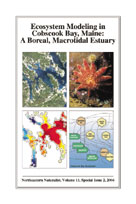Cobscook and Passamaquoddy Bays and their connecting passages lie at the entrance to the Bay of Fundy, on the eastern boundary between the United States and Canada where the mean tidal range is about 6 m. Vigorous tidal currents maintain cold temperatures and efficient exchange with offshore waters year-round. Over the last several decades, a net-pen salmon aquaculture industry has developed in both bays. Recent outbreaks of fish diseases have led to heightened concerns about tidal coupling between net-pen sites and potential pathways for disease transmission. This paper summarizes a Cobscook Bay circulation study by Brooks et al. (1999) and presents some new results to improve understanding of the tidal circulation and potential exchange pathways linking the bays.
A dipole pair of back-eddies forms in the central part of Cobscook Bay on each flood and plays an important role in the dispersion and retention of particles. Direct and indirect observations support the existence of the eddy pair and some associated flow details. Model flushing times are a day or two in the Outer Bay where most aquaculture lease sites are located but a week or longer in the inner arms of the Bay. The inner part of South Bay appears to be a repository for particulate matter. Model experiments including both bays and their connecting passages suggest that most water entering Cobscook Bay comes from Head Harbor Passage adjacent to Campobello Island, illustrating the importance of well-coordinated international plans for ecosystem management.





